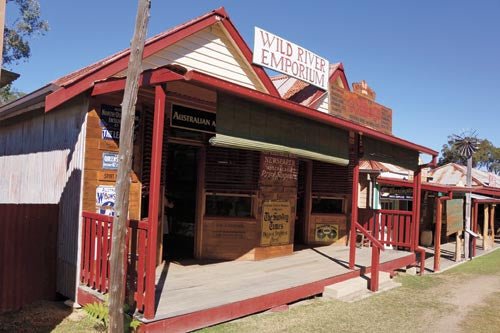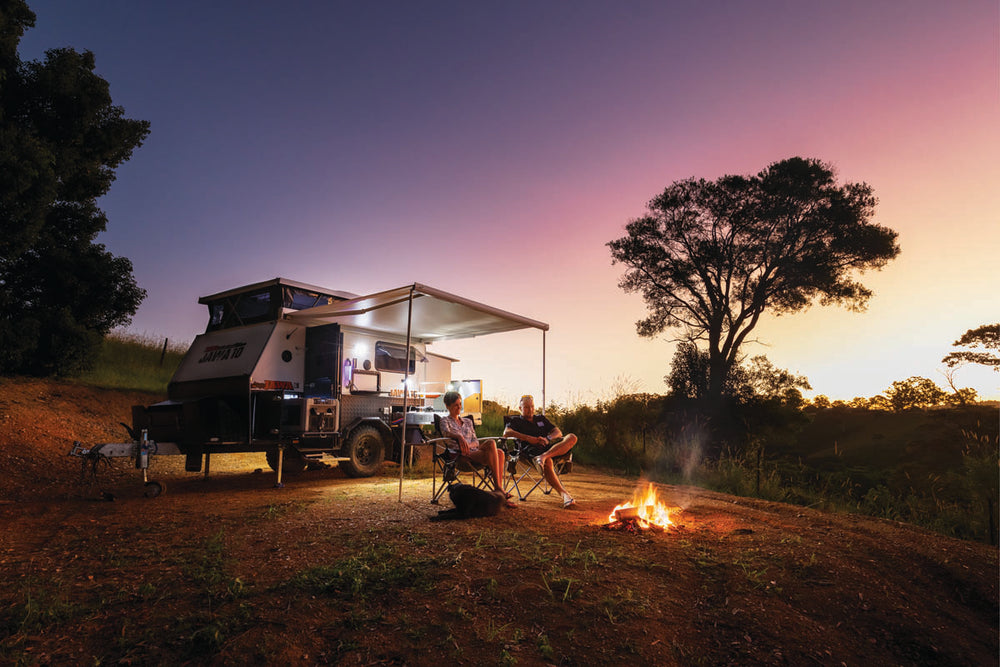TRAVEL: HERBERTON, QUEENSLAND

HIGHLIGHTS
• Well documented history and heritage buildings including Herberton Historic Village
• Walking tracks
• Cool climate
We had been looking forward to our visit to Herberton, Qld, as my family has lived in the area since the 1880s and I spent four years there at boarding school. We booked in to the Wild River Caravan Park for a few days so we could have a good look around, and what a good decision that turned out to be.
James Mulligan discovered tin in the Herberton area in 1875. By 1880, payable tin was found in Great Northern Gully, a few hundred metres from the present day mining museum. By later that year, Herberton had a pub, a butcher shop and three stores. It soon became the main town on the Atherton Tableland.
It did not to retain this pre-eminence once mining went into decline. But that has resulted in a large number of historically significant homes because, to some extent, finance was not available to knock them down and rebuild them. The whole Herberton precinct is now on the national heritage register.
The Herberton community is very aware of the historical importance of what they have, and there is a plan to have five inter-related and co-operative museums operating in the area. The most significant of the four already operating is the Herberton Historic Village.
HERBERTON HISTORIC VILLAGE
Years ago, a far-sighted local man named Harry Skinner began relocating buildings of historical significance to the Herberton site to try to preserve them, including my grandmother’s Bakerville Hotel (c. 1890). The sheer size of the task meant that not much progress was made until the village was sold three years ago. Craig and Connie Kimberley have made enormous progress with restoring the old buildings and installing displays of machinery, various vehicles and collectables. All this has been achieved using all local tradesmen and staff, all in a remarkably short time frame.
The restored Bakerville pub has a new life as tea rooms, which complements its original function. It is wonderful to see people sitting in the lounge having a meal or coffee, rather than having it wither away at its original site.
There are about 50 original buildings already in the village, and there are plans to develop another parcel of land behind the village. When you visit, make certain to include a visit to the coach house. Along with other remarkable pieces, there is a black horse-drawn hearse complete with ostrich feathers.
MINING AND SPY CAMERA MUSEUMS
The mining museum is part of the visitor information centre and can be viewed for a small fee. It documents the booms and busts of tin mining in the area and has a large mineral collection.
Visitors can also learn how to pan for alluvial tin.
At his spy camera museum, Michael Petersen conducts guided tours on the hour. This unique collection includes many pieces from the Cold War, and we were gobsmacked by the KGB button camera which was activated by a device held in the jacket pocket. It came with a range of buttons to suit different outfits and took very clear images. There was also an instrument which cut down 35mm film to use in the tiny camera.
The 40-minute tour will be of interest to everyone, even those who are not into photography, because of the fascinating pieces in this collection.
GREAT NORTHERN WALKING TRAILS
A system of walking trails, named for the Great Northern mine, has been set up adjacent to the visitor centre. Varying in length and difficulty, the colour coded trails showcase the most intact surface haulage plant in Australia, as well as many other mining relics. When we were there, grevilleas and some of the 30 local wattle varieties were in flower and there were carpets of white everlasting daisies. Collect a map before departing and make sensible preparations. Even on a cool July day, some parts of the track were rather warm.
The visitor centre also has a cottage garden with disabled access, a poet’s amphitheatre and a Tom Risley sculpture installation.
The Wild River Trail and Lions Park are very scenic. The concrete dam for the swimming pool in the river was built in 1933 by the CWA ladies and their menfolk, and is now maintained by the local Lions Club. It is a great place to sit and rest after your walk. The reflections are amazing and there are lots of birds.
IRVINEBANK
About 26km west of Herberton is the historical town of Irvinebank on the western slopes of the Great Dividing Range. About half of the road is sealed and the rest is a well-maintained gravel road suitable for all vehicles. On the way out, note the windmill in the middle of the road at Watsonville.
We packed a picnic lunch and enjoyed it in the little park beside McDonald Creek, where overnight camping is also allowed.
Named after the Irvine River in his Scottish birthplace by the entrepreneur John Moffat, Irvinebank was founded in 1882. In its heyday there were 3000 residents, pubs, churches and the impressive School of Arts. It was the centre of John Moffat’s amazing industrial empire. At one stage, he controlled 25 per cent of Australia’s base metal exports.
You should also visit the Loudon House Museum which is in Moffat’s original home – an 1884 high-set timber and corrugated iron building with views of the area. It contains useful historical records and I was able to see my grandmother’s attendance record at Stannery Hills School from more than a century ago.
Nearby are the Queensland National Bank built by John Moffat in 1905 and the impressive School of Arts Hall (1901). Looking across Loudon Dam you can still see the ore battery, after more than a century of ear-splitting operation. I remember the noise it made from childhood, during visits with my tin-mining uncles.
WILD RIVER CARAVAN PARK
This little gem of a park is operated by David and Sally Welburn. There are about 14 powered sites with slabs and a large camping area. The ensuite amenities are maintained to a very high standard. The park is home to a large number of birds including several varieties of parrot, honeyeaters and a flock of guinea fowl.
David is a painter and sculptor and examples of his work can be seen throughout the park. The rustic barbecue area has an open fire used by RVers during happy hour.
Because of the limited number of sites, this park fills quickly so it is a good idea to pre-book in the tourist season. Even in summer, weekend bookings are strong because of the mild climate in Herberton, which has lower humidity than the nearby tropical coast.
Although a magnet for living history buffs, Herberton has much to offer the active RVer. Really, you’ll need a full day each to see the Historic Village and Irvinebank, before doing the heritage and bush walks. Plan to stay a few days and enjoy the place at your leisure, rather than trying to cover it all on a day trip.
FAST FACTS
- Herberton Mining Museum and visitor information centre. Phone (07) 4096 3474, visit www.herbertonvisitorcentre.com.au or email: info@herbertonvisitorcentre.com.au.
- Herberton Historic Village Phone: (07) 4096 2002, www.herbertonhistoricvillage.com.au, Email: info@herbertonhistoricvillage.com.au
- Spy and Camera Museum. Phone: (07) 4096 2092, visit www.spycameramuseum.com.au or email spymuseum@gmail.com.
- Loudon House Museum, Irvinebank. Phone: (07) 4096 4020
- Wild River Caravan Park. Proprietors: David and Sally Welburn. Phone: (07) 4096 2121 or 0427 714 039
Originally published in Caravan World #506, September 2012.







